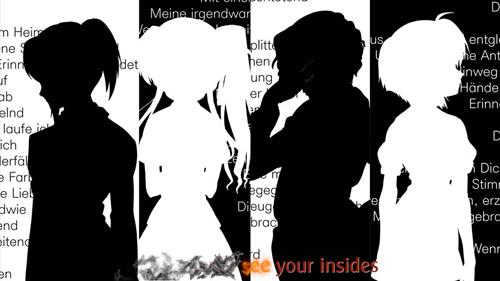
Every so often I’m noticing that silhouette is one of the most wildly used art in Japanese cartoons. Its intricacy and mystifying nature are so brilliant that it wonderfully presents harmony in complementariness—it’s so defined but yet so abstract. Now that I’m thinking more about it, lots of anime that I enjoyed incorporated this visual feature into their animations.
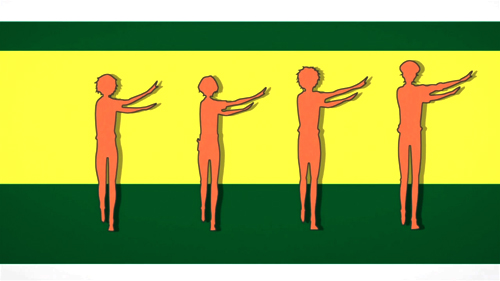
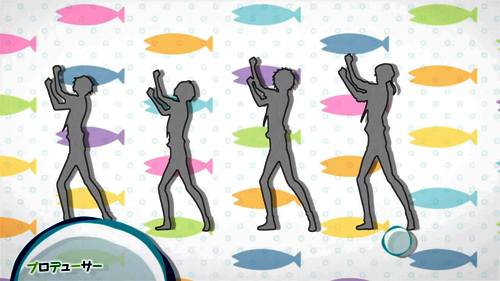
For sure lots of anime viewers are now picking their favourite OP’s and ED’s of the season. If there’s something that stands out for me, that would be to Tsuritama. I enjoy watching the use of silhouettes because it gives a fun visualisation. The light vibe and colourful ambience of the setting is not just a mere background rather it’s upfront “facial” value of the scene. Most of all, it’s pleasing how the booming posture and playful movements are nicely synchronized with the music and matched so well with the symmetry of the design.
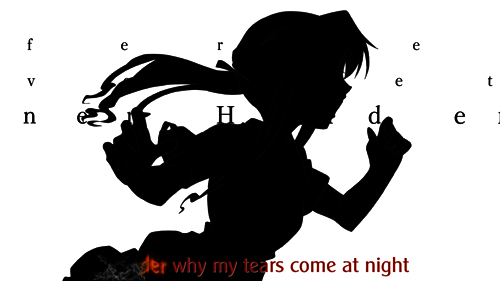
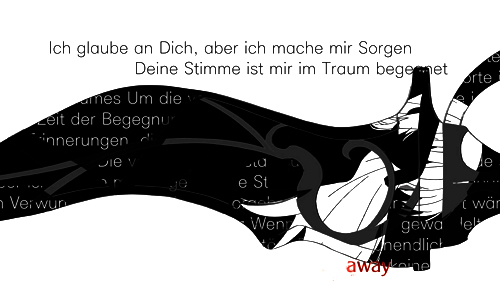
Another OP that I enjoyed not because of its music, but due to its animation is the one from Ef – A Tale of Melodies. The whole presentation embodies everything that I love in a design which is the showcasing of minimalism at its best because truly less is more. The vibrant use of the black and white tones poetically emphasized the melancholic nature of the series and the beauty of the art of 2D space.
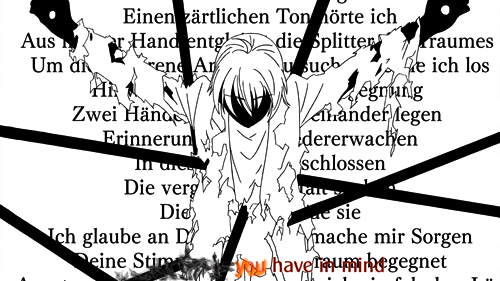
Aside from the clean lines and delightful visual profiles, it’s enjoying how it artistically integrated wordings into the design. And what even made it more perplexing is the fact that the words are in Deutsch—for I don’t understand the language. It felt like the texts were silhouetting my thoughts. They clearly outlined the feelings yet still left me hanging in mystery.
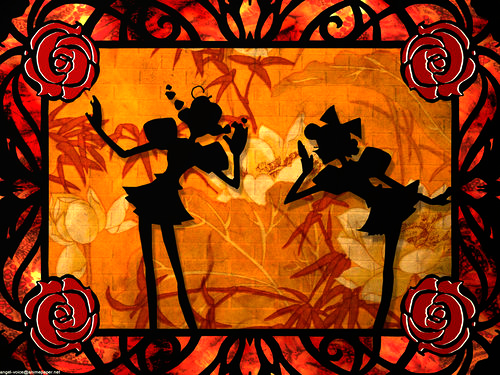
Speaking of mystery and silhouettes, who would’ve ever forgotten Ikuhara’s Revolutionary Girl Utena? The human’s perception of shadows is usually being linked to nothingness. An interesting sense, being nothing can be both meaningless and emblematic. Say for instance, I commend how Ikuhara cleverly used the shadow girls and likened them to the shadows of meaning themselves. Through these figurative shadow puppets, he’s able to illuminate nonsense by forming an absence of meaning which is pretty much just like how shadows are the absence of light.
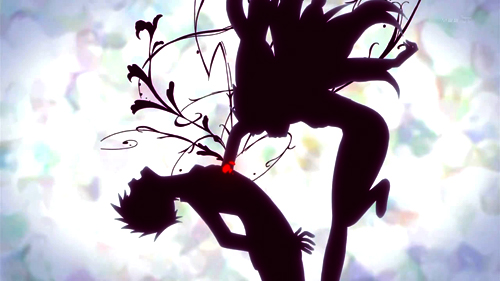
On a similar vein, Mawaru Penguindrum theatrically indulged the viewers and poignantly encapsulated the symbolisms through the use of shadows by entrenching some nonsense to keep the viewers speculating. However what I liked the most is how these beautifully outlined the profiles of the characters. The sharp-edged and finely formed solid shapes of the human body are such visual delights.
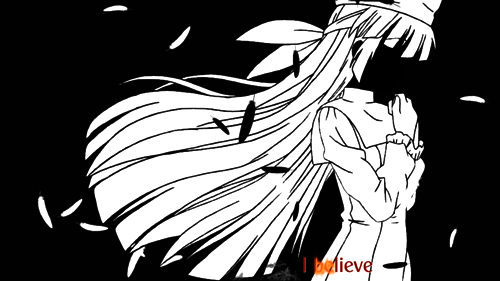
So perhaps the very idea of absences cause things makes the visualisation of silhouettes so fascinating. It’s really indeed amazing how a clear image can be so featureless and at the same time unleash a mystifying and imaginative nature.

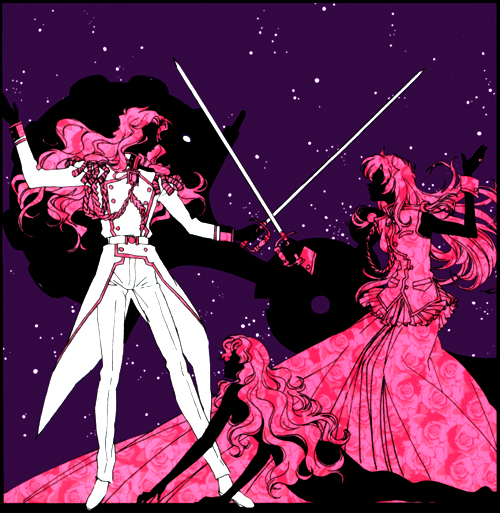
There is power in emptiness, but I really love how the silhouette accents form without ‘depth’. It removes a dimension, making the image flat but more specific at the same time.
Indeed. Also, I like a dimensionless space for its simplicity, sometimes when the depth it missing it makes me think more than I should.
Abstraction does have a lot of depth with in itself. Like with what you said, their could be a myraid of echoes within one frame than their is an entire episode, but the interperation could lead to anything to the average viewer that the director probably only knows. I love the visual piece from Ef – A Tale, but could not tell you word of what the words means. At best, all I can do is speculate the words and images.
Myriad of echoes… interesting thought, I like it.
I have similar thoughts with Ef’s wordings. It’s so well laid out but yet so abstract. So wonderful!
I love ef, I love Utena, what more can I say? Ofc the whole post is very insightful :)
Oh well, Shadow Girls aren’t simply nonsense. the silouhettes are something abstract and they do present sth abract, since they are the anime’s Chorus (like the ancient Greek Drama).
I, also, believe that they are used for more emotional engagement from the reader’s part, as he/she can ‘write’ him/herself on this.
oh the german lyrics from the backgrounds are the lyrics of Yuuko’s song.
Oic… but when I talked about nonsense in Ikuhara’s work, I was actually pertaining to the excess of meaning, rather than a lack of it. Kind of like the humour is concealing it.
Oh I misunderstood. Also, sorry for the typos. I don’t know what’s up with me lately…
I haven’t seen Ef – A Tale of Melodies yet (forgive me), but I loved the silhouettes in the OP and ED to Ef – A Tale of Memories, particularly the one of Kei running.
It’s actually the OP that brought me into watching Ef. Hopefully, you’ll find time to check it out.
Btw, I noticed that it’s your first time commenting here, thanks for dropping by. ^^
I’ll probably never forget about the Kashira Shadow girls whenever talks about silhouettes are concerned ^^
The thing I find most appealing (and sometimes amusing even) about silhouettes is that they leave a lasting impression, regardless of how we see them. I agree that it’s abstraction gives a sense of minimalism, and to some extent, nothingness. Looking at it from another angle it could be a play on how much do we perceive things – how much are we willing to “see”, as supposed to what is really shown.
Very well said. A lot of times with these silhouettes, we tend to overlook certain things. Because of this, shadows (dark and light hues, for the most part) continue to fascinate me because of their capability to mind-trick us. And it’s kind of ironic because come think about it, silhouettes are composed of nothing, yet it creates something.
Too deep for me to understand or be concerned with the effects of shadows. Then again, I have seen its effects in action in games such as Limbo, This post also reminds me of “Bad Apple”. Good stuff. Then there’s that OP from Natsu no Arashi, but that’s more of a sexual nature.
Hmm, shadow effects…
@Overlord-G: I also thought about “Bad Apple” (for visitors who should not know this awesome Touhou PV: http://www.youtube.com/watch?v=G3C-VevI36s ) when I read this post!
It looks to me as if the creators were using 3D models. If so, it would be a remarkable “less is more” approach to artificially reduce 3D characters to their silhouettes. The link to “nothingness” is also played nicely in the video as the characters just almost disappear and are transformed in raindrops etc. out of which some other character emerges.
@SnippetTee: I loved both Utena’s and ef’s play with shadows/ silhouettes – in particular your last picture of Yuuko is awesome!
@Overload-G and @jreding I was also thinking of adding the Bad Apple but I couldn’t remember the title. And indeed, it’s really nicely animated. It was actually the one that brought me to Touhou.
Silhouettes have always been an interesting artistic style. What I usually relate them to is the idea that what we’re seeing is in some way off from whatever is normal. I see that Penguindrum picture and I honestly can’t tell if it’s supposed to be a real event or some sort of imaginary scene, for instance. In some way, I can just tell that it isn’t a normal event.
Indeed, sometimes we can for something so many images with silhouettes and it’s really fascinating. For instance, this visual illusion is quite common.
Silhouettes are always a good element to enhance imaginations and abstractness. It is indeed quite interesting, shadows amount to darkness and darkness always give us the most vague answers. Although the vague impressions could be turned into revelations using deductive abilities via human minds. Human thoughts can be quite imaginative and creative.
Indeed, it’s because of the power of the human mind that we started to imagine these abstractions, come to think of it silhouettes are nothing but plain image. It’s only when we attached symbolisms and meanings to what we’re seeing that shadows start to make sense.
Thanks for dropping by and for the thoughtful comment.
What a coincidence, my friends and I were just talking about silhouettes in anime a few weeks ago. We came to a different conclusion though, that they were being used to help anime give off the feel of being artsy while saving money on production costs.
That’s an interesting thought. I think for an overly simple art it’s either a hit or miss. If you do it right it’s awesome if not, it’s a total flop, so investing money on silhouette-art is a risk, I guess.
Reblogged this on compass on my field trip.
Pingback: The Anime Blogger Interrogation Game « Lemmas and Submodalities